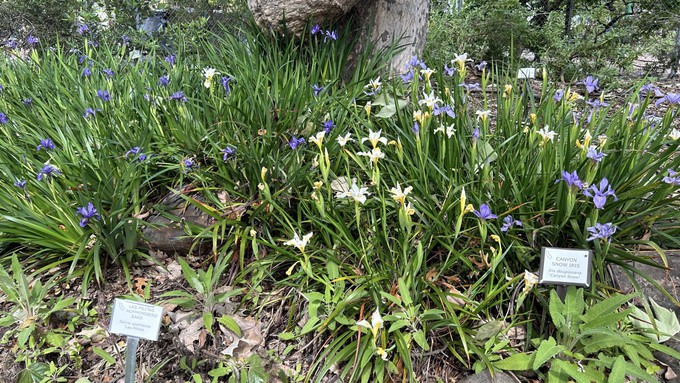
Get advice from local experts; see how they tackle spring tasks

Native Douglas irises -- as well as the 'Canyon Snow' cultivar irises -- are in bloom at the Fair Oaks Horticulture Center this week, which also happens to be California Native Plant Week. Kathy Morrison
Spring stirs thoughts of gardening – and lots of questions. Here’s your chance to get expert advice from Sacramento County master gardeners during a (hopefully) sunny midweek morning.
From 9 a.m. to noon Wednesday, April 17, the master gardeners will host an Open Garden event at Fair Oaks Horticulture Center in Fair Oaks Park – rain or shine. Admission and parking are free.
See the latest renovations and additions to this growing resource. Watch master gardeners as they tend to spring tasks and prepare for summer planting and rapid growth.
“For gardeners, there is no better time than spring to get inspired and tap into some practical and scientific know-how,” say the organizers. “Join Sacramento’s UC Master Gardeners to view new and established plantings and get locally relevant answers to your gardening questions.”
Master gardeners will be available to answer questions. Bring photos and samples of pests and/or problem plants, if desired (in zippered plastic bags). Got a garden mystery? These garden detectives are ready to help.
Stroll around the Hort Center and see what the master gardeners are busy doing this week. Ask questions! They love to talk gardening.
Some areas of interest:
BERRIES: Loganberries and ‘Baby Cakes’ raspberries are joining the berry garden. See how the various blueberry plants are doing.
HERBS: International culinary herb beds are making room for new annuals. Sniff the scented pelargoniums and the various lavenders. View edible flowers such as calendula and Johnny jump-ups.
VEGETABLES: Beds are being cleared of cover crops and revitalized with compost and fertilizer. As the soil warms, All-America Selections of tomatoes, flowers and vegetables will be planted.
ORCHARD: As the citrus harvest concludes, trees are being fertilized and pruned. Other sections of the orchard are being prepared for new trees including some in containers.
WATER-EFFICIENT LANDSCAPE: Subtropical varieties are being tried the Sacramento area in anticipation of climate change.
Fair Oaks Horticulture Center is located at 11549 Fair Oaks Blvd., Fair Oaks, south of the Fair Oaks Library.
Details and directions: https://sacmg.ucanr.edu.
Comments
0 comments have been posted.Sacramento Digs Gardening to your inbox.
Sites We Like
Garden Checklist for week of July 21
Your garden needs you!
* Keep your vegetable garden watered, mulched and weeded. Water before 8 a.m. to reduce the chance of fungal infection and to conserve moisture.
* Feed vegetable plants bone meal, rock phosphate or other fertilizers high in phosphate to stimulate more blooms and fruiting. (But wait until daily high temperatures drop out of the 100s.)
* Don’t let tomatoes wilt or dry out completely. Give tomatoes a deep watering two to three times a week.
* Harvest vegetables promptly to encourage plants to produce more. Squash especially tends to grow rapidly in hot weather. Keep an eye on zucchini.
* Pinch back chrysanthemums for bushy plants and more flowers in September.
* Remove spent flowers from roses, daylilies and other bloomers as they finish flowering.
* Pinch off blooms from basil so the plant will grow more leaves.
* Cut back lavender after flowering to promote a second bloom.
* It's not too late to add a splash of color. Plant petunias, snapdragons, zinnias and marigolds.
* From seed, plant corn, pumpkins, radishes, winter squash and sunflowers.